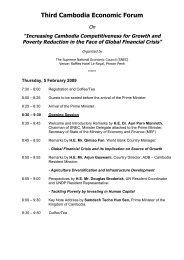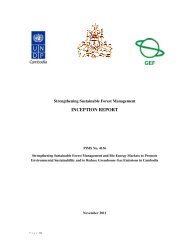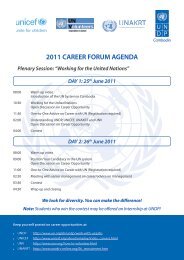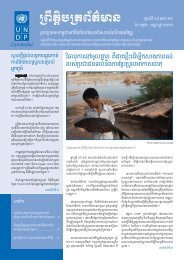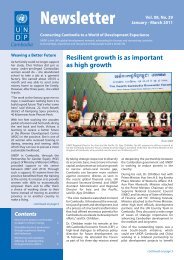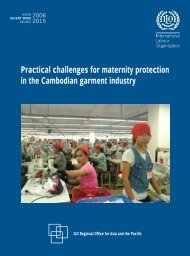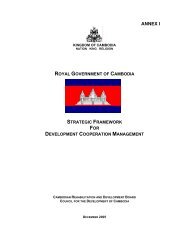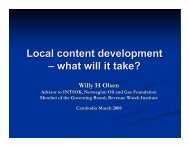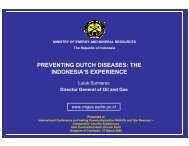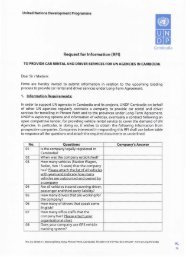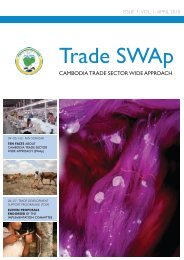UN Analysis Final.pdf - United Nations in Cambodia
UN Analysis Final.pdf - United Nations in Cambodia
UN Analysis Final.pdf - United Nations in Cambodia
Create successful ePaper yourself
Turn your PDF publications into a flip-book with our unique Google optimized e-Paper software.
This study found that youth conceptions of volunteerism may depend on the benefits or advantages they<br />
can derive from it. Youths generally perceive volunteer<strong>in</strong>g as work that does not offer a salary. Not everyone<br />
thought it was a great idea. One 19-year-old said that: “Voluntary work <strong>in</strong> the community is a useless waste of<br />
time.” Some did not hold a positive view of volunteerism even if they had no experience of it.<br />
On the other hand, ethnic youth <strong>in</strong> Ratanakiri prov<strong>in</strong>ce said they liked to work as volunteers. They believe their<br />
participation can strengthen their understand<strong>in</strong>g and help their community:<br />
I used to work as volunteer with many local NGOs that implement projects <strong>in</strong> my community and I ga<strong>in</strong>ed<br />
more understand<strong>in</strong>g about development and how to strengthen the community. From this experience I<br />
became a successful youth activist and I currently have created a community-based organisation to help<br />
the youth <strong>in</strong> my village... – 23-year-old male, Ratanakiri<br />
Volunteer<strong>in</strong>g work among youths seems to be shaped by the availability of support, usually from an NGO.<br />
This idea is substantiated by a recent study <strong>in</strong> which young student respondents expressed will<strong>in</strong>gness to<br />
volunteer provided that there was some means of support (Mysliwiec 2005). The same students saw their<br />
role to be one of teach<strong>in</strong>g or impart<strong>in</strong>g their knowledge to others. However, none viewed volunteerism<br />
<strong>in</strong> reciprocal terms or stated that they could also learn someth<strong>in</strong>g from the people and communities they<br />
would be work<strong>in</strong>g with (Mysliwiec 2005).<br />
There are <strong>in</strong>dications that volunteer<strong>in</strong>g is ga<strong>in</strong><strong>in</strong>g traction <strong>in</strong> <strong>Cambodia</strong>’s rural areas. EveryChild-<strong>Cambodia</strong><br />
(2006) found 84 child- and youth-led clubs and organizations across the country, although some are local<br />
divisions or branches of NGOs that facilitate programmes for children and youths (Annex 8-1 <strong>in</strong> Appendix A).<br />
The activities of these associations <strong>in</strong>clude leadership tra<strong>in</strong><strong>in</strong>g, home-based care (for people liv<strong>in</strong>g with HIV<br />
and AIDS), primary health care, child rights promotion, monitor<strong>in</strong>g child abuse, capacity build<strong>in</strong>g for club<br />
members, hold<strong>in</strong>g literacy classes. In a 2007 CARE survey <strong>in</strong> Koh Kong, 15-24 year-old <strong>in</strong>terviewees claimed<br />
to participate <strong>in</strong> several associations and activities <strong>in</strong> their villages, such as sav<strong>in</strong>gs groups, home-based<br />
care-related activities, sports, and a group that works on the environment, sanitation and hygiene.<br />
This suggests that, while some have a negative attitude towards volunteerism (believ<strong>in</strong>g that it detracts from<br />
<strong>in</strong>come generation), there rema<strong>in</strong>s a sense of altruism among many, particularly <strong>in</strong> rural areas. In terms of<br />
the development of social capital, the above accounts also demonstrate that, if the youth of <strong>Cambodia</strong> can<br />
move beyond the traditional concept of ’charitable’ voluntary work, volunteerism can become a worthwhile,<br />
<strong>in</strong>clusive form of participation that expresses solidarity, fosters social cohesion and promotes participatory<br />
development. Volunteerism, <strong>in</strong> fact, bridges diverse pathways of participation to promote social, economic<br />
and political development. “Help<strong>in</strong>g to do the right th<strong>in</strong>g, and help<strong>in</strong>g people, goes together with promot<strong>in</strong>g<br />
a system that is more just and more equitable” (<strong>UN</strong>V/IAVE/CIVICUS 2008).<br />
8.3 OPPORT<strong>UN</strong>ITIES FOR YOUTH PARTICIPATION AND ANALYSIS<br />
8.3.1 OPPORT<strong>UN</strong>ITIES FOR POLITICAL PARTICIPATION<br />
Young <strong>Cambodia</strong>ns could also contribute by engag<strong>in</strong>g the State as citizens and as constituents <strong>in</strong> the<br />
electoral process (e.g. <strong>in</strong> the National Assembly and Commune Council elections). For those aged 18-24,<br />
such engagement br<strong>in</strong>gs an opportunity to help determ<strong>in</strong>e the election of local and national leaders who<br />
can represent young people’s needs and <strong>in</strong>terests.<br />
Situation <strong>Analysis</strong> of Youth <strong>in</strong> <strong>Cambodia</strong><br />
93




